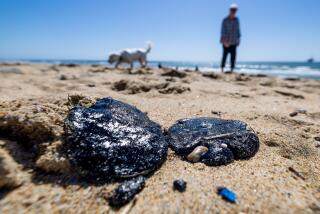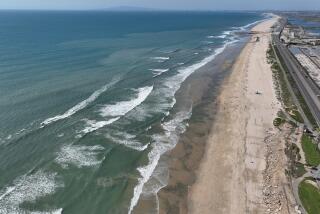Obama takes responsibility for coping with spill
- Share via
Reporting from Los Angeles and Kenner, La. — — As BP continued a hydraulic arm-wrestle with its renegade well, President Obama toured Louisiana’s soiled beaches Friday and vowed to take responsibility for solving the oil spill crisis.
“I am the president and the buck stops with me,” he said during a televised beachfront gathering of Gulf Coast governors, senators and local officials in Grand Isle.
He said the government would hold BP legally and financially responsible for the damage.
But as demands mount for a more vigorous federal response to the oil seeping into wetlands, curtailing the region’s fishing economy and drying up tourism, Obama also sought to lower expectations.
“America has never experienced an event like this before,” he said. “That means that, as we respond to it, not every judgment we make is going to be right the first time out.”
Given the magnitude of what he called “a man-made catastrophe that is still evolving,” Obama added, “There are not going to be silver bullets or a lot of perfect answers for some of the challenges that we face.”
Obama’s visit, on a humid, slightly breezy day, was his second to the gulf since the April 20 explosion that killed 11 rig workers and triggered the biggest oil spill in U.S. history. As much as 29 million gallons may have spilled so far, according to government estimates.
On his way to a briefing in the town of Grand Isle, the president stopped at Fourchon Beach, where he inspected booms, picked up a handful of tar balls and pointed out dolphins swimming offshore as evidence of the gulf’s “precious wildlife.”
On Grand Isle’s Main Street, signs read, “Lead follow or get out of the Gulf,” “Welcome Mr. President” and “Shame on you BP.” Obama’s arrival brought people out of their beach houses to perch on porch swings and lawn chairs.
Nearly 50 miles offshore, BP struggled to overwhelm the geyser of oil pushing up its well by pumping heavy drilling fluid and other “junk” materials into the well at high speed and under high pressure. BP officials said they had made progress but would be unable to judge the ultimate success of the operation before Sunday.
Chief Operating Officer Doug Suttles called the “top kill” operation “a bit like a roller-coaster,” alternating between shooting in drilling mud, pausing to take pressure tests, and pushing in rubber and other materials. “The fact that it stopped and started is not unusual,” he added.
Should the top kill fail, Suttles said, engineers are preparing a “lower marine riser package” to place over the blowout preventer and are considering stacking another blowout preventer above that apparatus. Drilling of one relief well halted, while another continued.
Obama announced that the federal government would triple the number of personnel involved in the cleanup and monitoring of the spill in places where oil has hit the shore or is within 24 hours of impact.
So far, 20,000 people have been mobilized overall, including 1,400 National Guard soldiers.
Doctors and scientists are being deployed along the coast, at BP’s expense, to monitor residents and track the health effects of the spill and offer care, Obama said.
He also pledged that people and businesses affected by the spill could get help by going to the White House website, https://www.whitehouse.gov, and that the White House would cut through “bureaucratic problems.” And in a message directed at Gulf Coast officials, he said: “If something is not going right,” they should contact Coast Guard Adm. Thad Allen or “get in touch with me directly.”
“We’re on your side and we’re going to see this through until your communities are made whole again,” Obama said.
“I give the people of this community and the entire gulf my word that we’re going to hold ourselves accountable.”
Though the Louisiana coastline is the only area severely affected, Florida scientists back from a research voyage Friday reported an underwater layer of dissolved hydrocarbons at least 20 miles long beneath the surface of the gulf.
The discovery appeared to confirm evidence from another research vessel a week ago.
Scientists say the far-flung subsea oil results from the use of dispersants that break up oil on the surface and distribute smaller particles into the water column. “We have all the circumstantial evidence pointing to a layer of oil at 400 meters,” or about 1,300 feet, said Ernst Peebles, an associate professor of biological oceanography at the University of South Florida.
Peebles said the ship’s sonar detected a thick “structure” about a quarter of a mile deep and about 45 miles northeast of the leaking well. He said the scientists had found a similar layer of hydrocarbons and particulates at about 3,300 feet deep, 24 miles from the well.
The National Oceanic and Atmospheric Administration announced Friday it would launch its own research ship.
NOAA has extended the closed fishing area in the Gulf of Mexico to include a large area of oil sheen patches crossing the eastern edge of the current boundary, as well as an area currently outside the southern boundary. The closed area represents 60,683 square miles, which is approximately 25% of the federal waters in the gulf.
Meanwhile, testifying before a federal investigation panel in Kenner, La., a supervisor on the Deepwater Horizon rig gave a chilling picture of last-minute chaos before the explosion on April 20.
Christopher Pleasant, who was in charge of the blowout preventer, said he and a colleague had glanced at television monitors and noticed water and mud issuing from the well. Pleasant testified that he tried to contact superiors by ship phone but could not get through. By the time he reached the bridge, there was fire on the deck.
Pleasant said he told the captain, Curt Kuchta, that he wanted to launch the emergency disconnect system, or EDS, designed to detach the rig from the well.
But Kuchta replied, “Calm down. We’re not EDS-ing,” according to Pleasant. About four to five minutes later, Pleasant said, he launched the procedure anyway, only to find the hydraulic system was not responding.
“I saw that I had no flow, no hydraulics.… There were no indications that anything actually happened,” he said.
Pleasant said that after he ran to the main deck and saw the fire, “four to five minutes later, the captain said, ‘Hit the EDS.’ I said, ‘I already have.’ ”
His testimony before a joint panel of the Coast Guard and the federal Minerals Management Service is consistent with other evidence that the rig could not disconnect from the well, which continued to spew oil and gas up a riser pipe to the surface.
Kuchta testified before the panel Thursday, offering a different scenario. He said he was on the bridge with BP and Transocean Ltd. executives, using a simulator, when he noticed drilling mud in the water. He said another manager came to him to ask to engage the emergency disconnect, which he approved.
Times staff writers Nicole Santa Cruz in Grand Isle and Julie Cart and Bettina Boxall in Los Angeles contributed to this report.
More to Read
Sign up for Essential California
The most important California stories and recommendations in your inbox every morning.
You may occasionally receive promotional content from the Los Angeles Times.












